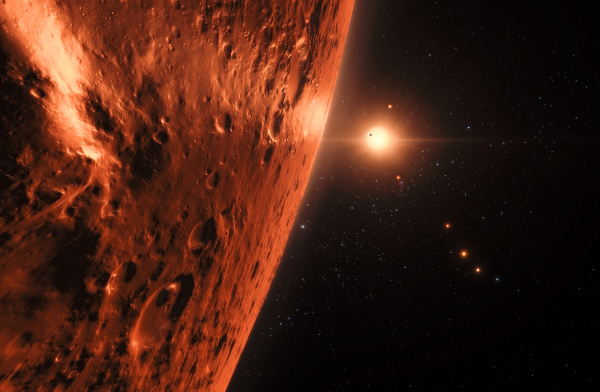Hubble delivers first hints of possible water content of TRAPPIST-1 planets [heic1713]
31 August 2017
An international team of astronomers used the NASA/ESA Hubble Space Telescope to estimate whether there might be water on the seven earth-sized planets orbiting the nearby dwarf star TRAPPIST-1. The results suggest that the outer planets of the system might still harbour substantial amounts of water. This includes the three planets within the habitable zone of the star, lending further weight to the possibility that they may indeed be habitable. |
| Artist's impression of the TRAPPIST-1 planetary system. Credit: ESO/N. Bartmann/spaceengine.org |
On 22 February 2017 astronomers announced the discovery of seven Earth-sized planets orbiting the ultracool dwarf star TRAPPIST-1, 40 light-years away [1]. This makes TRAPPIST-1 the planetary system with the largest number of Earth-sized planets discovered so far.
Following up on the discovery, an international team of scientists led by the Swiss astronomer Vincent Bourrier from the Observatoire de l'Université de Genève, used the Space Telescope Imaging Spectrograph (STIS) on the NASA/ESA Hubble Space Telescope to study the amount of ultraviolet radiation received by the individual planets of the system. "Ultraviolet radiation is an important factor in the atmospheric evolution of planets," explains Bourrier. "As in our own atmosphere, where ultraviolet sunlight breaks molecules apart, ultraviolet starlight can break water vapour in the atmospheres of exoplanets into hydrogen and oxygen."
While lower-energy ultraviolet radiation breaks up water molecules – a process called photodissociation – ultraviolet rays with more energy (XUV radiation) and X-rays heat the upper atmosphere of a planet, which allows the products of photodissociation, hydrogen and oxygen, to escape.
As it is very light, hydrogen gas can escape the exoplanets' atmospheres and be detected around the exoplanets with Hubble, acting as a possible indicator of atmospheric water vapour [2]. The observed amount of ultraviolet radiation emitted by TRAPPIST-1 indeed suggests that the planets could have lost gigantic amounts of water over the course of their history.
This is especially true for the innermost two planets of the system, TRAPPIST-1b and TRAPPIST-1c, which receive the largest amount of ultraviolet energy. "Our results indicate that atmospheric escape may play an important role in the evolution of these planets," summarises Julien de Wit, from MIT, USA, co-author of the study.
The inner planets could have lost more than 20 Earth-oceans-worth of water during the last eight billion years. However, the outer planets of the system – including the planets e, f and g which are in the habitable zone – should have lost much less water, suggesting that they could have retained some on their surfaces [3]. The calculated water loss rates as well as geophysical water release rates also favour the idea that the outermost, more massive planets retain their water. However, with the currently available data and telescopes no final conclusion can be drawn on the water content of the planets orbiting TRAPPIST-1.
"While our results suggest that the outer planets are the best candidates to search for water with the upcoming James Webb Space Telescope, they also highlight the need for theoretical studies and complementary observations at all wavelengths to determine the nature of the TRAPPIST-1 planets and their potential habitability," concludes Bourrier.
Notes
[1] The planets were discovered using: the ground-based TRAPPIST-South at ESO's La Silla Observatory in Chile; the orbiting NASA Spitzer Space Telescope; TRAPPIST-North in Morocco; ESO's HAWK-I instrument on the Very Large Telescope at the Paranal Observatory in Chile; the 3.8-metre UKIRT in Hawaii; the 2-metre Liverpool and 4-metre William Herschel telescopes at La Palma in the Canary Islands; and the 1-metre SAAO telescope in South Africa.
[2] This part of an atmosphere is called the exosphere. Earth's exosphere consists mainly of hydrogen with traces of helium, carbon dioxide and atomic oxygen.
[3] Results show that each of these planets have may have lost less than three Earth-oceans of water.
More information
The Hubble Space Telescope is a project of international cooperation between ESA and NASA.
The team of the study is composed of V. Bourrier (Observatoire de l'Université de Genève, Switzerland), J. de Witt (Massachusetts Institute of Technology, USA), E. Bolmont (Laboratoire AIM Paris-Saclay), V. Stamenkovic (Jet Propulsion Laboratory, USA; California Institute of Technology, USA), P. J. Wheatley (University of Warwick, UK), A. J. Burgasser (University of California San Diego, USA), L. Delrez (Cavendish Laboratory, UK), B.-O. Demory (University of Bern, Switzerland), D. Ehrenreich (Observatoire de l'Université de Genève, Switzerland), M. Gillon (Université de Liège, Belgium), E. Jehin (Université de Liège, Belgium), J. Leconte (Université Bordeaux, France), S. M. Lederer (NASA Johnson Space Center, USA), N. Lewis (Space Telescope Science Institute, USA), A. H. M. J. Triaud (Institute of Astronomy, Cambridge, UK, now at University of Birmingham, UK) and V. van Grootel (Université de Liege, Belgium).
Contacts
Vincent Bourrier
Observatoire de l'Université de Genève
Sauverny, Switzerland
Tel: +41 22 379 24 49
Email: vincent.bourrier![]() unige.ch
unige.ch
Julien de Wit
Massachusetts Institute of Technology
Cambridge, USA
Tel: +1 54 1726
Email: jdewit![]() mit.edu
mit.edu
Mathias Jäger
ESA/Hubble, Public Information Officer
Garching bei München, Germany
Tel: +49 176 62397500
Email: mjaeger![]() partner.eso.org
partner.eso.org




